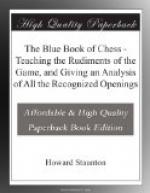[Footnote A: If Black had taken the B. with K. B. P. at this point, the following moves show that he would have equally lost:—
31. P. takes B.
32. Q. takes Kt. 32. P. takes P. (ch.)
33. K. to R’s sq. 33. Q. takes Q. P.
34. Q. to K. Kt’s 3d. (ch.), and wins.]
GAME THE NINTH.
THE GIUOCO PIANO.
An attentive examination of the eight separate methods of reply to your second move of K’s Kt. to B’s 3d in the antecedent games, will have enabled you to understand that four at least of these defences, viz.: P. to K. B’s 3d, B. to Q’s 3d, Q. to B’s 3d, and B. to Q. B’s 4th, are untenable and injurious for the game of the second player, and that the remaining four, if not absolutely bad for him, are unsatisfactory, because against the best attack, they leave the balance of advantage in favor of the party playing first.
It is now time to consider the consequences to both parties when Black, abandoning the objectionable or uncertain modes of play he has hitherto adopted, shall answer with the move which the best authorities at length concur in recommending as the proper one, i.e. 2. Q’s Kt. to B’s 3d. Upon his playing thus, you have the choice of three good moves: in the first place to play 3. K’s B. to Q. B’s 4th, as in the present game; secondly, 3. P. to Q’s 4th; and thirdly, P. to Q. B’s 3d. The two latter of which will form the subjects of games hereafter.




